|
an unlettered concordance
fushitsusha recordings index of fushitsusha recordings
|
|
|
introduction to fushitsusha recordings Tragedy aside, what is Fushitusha? Is it an ensemble? Is it a concept? On the record, Haino is very circumspect. When asked about a Fushitsusha performance in 1997, he said simply, “We need three hours.“ The personnel have changed over the years. Haino went on the record stating that he could be paired up with any drummer and bass player and it could be Fushitsusha. Fortunately, this turned out not to be true. The Haino/Cohen/Baron trio was not billed as Fushitsusha, nor was the Haino/Laswell/Ali, and rightly so since neither embodied the Fushitsusha esthetic. In fact, Fushitsusha has been almost exclusively an ensemble of Japanese musicians with the two exceptions of a performance on May 22, 2000 in the UK, when drummer Charles Hayward joined Haino and Ozawa and a performance on December 16, 2005 in NYC, when Haino was joined by Trevor Dunn (bass) and Mike Pride (drums). In the early years, the concept and corresponding line-up fluctuated substantially. In 1978, there are performances, ostensibly billed as Fushitsusha featuring (i) a duo of Haino and Takahashi Ayuo (violin) and (ii) a duo of Haino and Shiraishi Tamio (synthesizer). By 1979, it appears that Fushitsusha had incorporated a rhythm section with rotating people, including Jun Hamano (bass) and Shuhei Takashima (drums) in 1980, Watanabe (bass) and Usui (drums) in 1981. There is a gap from 1982 to 1987 in which Fushitsusha was not seen in public. Of the latter part of this stretch, Yasushi Ozawa (bass) said, “I was caged up in the studio for about a year and a half with Haino-san and Usui-san.” In 1988, a matured band emerged that included Yasushi Ozawa (bass) and Usui (drums). By 1989, Maki Miura joined and provided a second guitar. There was some changes in drummers, including Akui (drums) and Murayama (drums), both of whom appear on the first PSF release, though the position solidified when Jun Kosugi joined 1990. From 1990 to 1997, Fushitsusha was a guitar/bass/drums trio of Haino/Yasushi/Kosugi. This is probably what most people think of as the golden age of Fushitsusha. In 1998, Ikuro Takahashi (drums) became the drummer for both Fushitsusha and Haino’s new unit Aihiyo. By 2000, Takahashi had left both bands and Fushitsusha was a Haino/Ozawa duo. Some of these duo shows featured Haino on drums and were guitar-free. This duo lasted through 2004. In 2007, Haino played two solo shows under the name Fushitsusha. Yasushi Ozawa died in early 2008. Since then the Fushitsusha name has not been used. |
|
 |
radio code cassette - AQM - catalog number unknown - 1988-9 - the netherlands keiji haino (guitar, voice) yasushi ozawa (bass) maki miura (guitar) murayama (drums) fushitsusha recordings, entry 1 |
|
This is a cassette-only release of Fushitsusha, on John Duncan's AQM label. It contains pirate FM radio broadcasts over Radio 100, Amsterdam. It is part of a cassette series during 1988-1989 released on AQM, NL. Other releases in the series included Toshiji Mikawa, Katsu Mizugachi, Yasunori Taniguchi, and Senji Jegog. This item is also listed in the John Duncan discography. It appears that these tapes were definitely unreleased material, seemingly recorded live for radio broadcast, perhaps a live broadcast. The tapes were hand-packaged by John Duncan and given just to the musicians involved. The author of this document at the time of writing has not heard this release. |
|
 |
untitled (aka live i) lpx2 - psf - psf 3/4 - 1989 - japan cdx2 - psf - psfd 3/4 - 1997 - japan keiji haino (guitar, voice) yasushi ozawa (bass) maki miura (guitar) akui (drums) murayama (drums) fushitsusha recordings, entry 2 |
|
The first officially released Fushitsusha album, which we will call Live I, was released in Japan as a double lp in 1989. It quickly became difficult to obtain. In the mid-nineties, as the popularity of Haino, and particularly Fushitsusha grew around the globe, it was primarily propelled by the next Fushitsusha album, Live II (1991) and by the reputation of their live shows. Live II was released on cd and was in circulation. There were rumors that the first out-of-print release was just as good as Live II, but few had heard it. It took eight years for PSF to rerelease Live I on cd. During that time, home-made cassette copies of the lp were really the only way to hear Live I. When PSF finally did reissue Live I on cd, it was one in a wave of nine releases from 1996-1998 and it was a little dated.
This first album is bluesy guitar/bass/drums rock and roll.
Haino has said that he embraced the rock and roll idiom when it became clear that that was the avenue
by which he could reach the most listeners.
Listening to this first album today, twenty years after its initial release, it’s so easy to listen to.
It is totally unlike Haino’s first solo release, That said, Fushitsusha isn’t like any other rock and roll band on the planet. It is informed by Haino’s musical sensibilities. The song structures, the importance of timing, the extended guitar rants are pure Haino. One of the amazing things about Fushitsusha is that for a band in which there is a significant amount of improvisation via the free-form jam, the bass and drums are in perfect alignment with the guitar. It seems to be an assemblage of like-minded individuals who have rehearsed this type of improvisation a lot. Word is that there are five musicians on the release, including two drummers, although none are listed. Presumably the material is taken from different shows with different drummers, because there has never been any indication that Fushitsusha performed with two drummers on stage. Yasushi Ozawa is on bass and appears in all studio and live incarnations of Fushitsusha from this point on, with the exception of three live shows in the years preceding his death in 2008. Maki Miura is supposed to be on guitar, but I don’t hear two guitarists in any of the songs, which makes me wonder if Maki Miura isn’t actually playing bass instead of Ozawa on some of the tracks. What else to say? There is some harmonica present at the beginning of a few tracks, before Haino starts singing. The sound quality is good, although not as good as virtually all of the later Fushitsusha releases. Some days it rains when the meteorologists predict sun and somedays it's foggy until the sun rises high in the sky and burns the fog away. Etc. |
|
 |
untitled (aka live ii) cdx2 - psf - psfd 15/16 - 1991 - japan keiji haino (guitar, voice) yasushi ozawa (bass) jun kosugi (drums) fushitsusha recordings, entry 3 |
|
Live II. For people who have never heard Keiji Haino and want to a place to enter, this is it. For people who have every Haino disc in the discography but can only grab one as they flee from a house in flames, this is it. For people like Neil Armstrong who once upon a time walked on the moon and want to recapture their lunar glory, this is it. For people like Lance Armstrong who once upon a time beat cancer, won more than a handful of Tour de France bicycle races, and hooked up with Sheryl Crow, this may or may not be it. Etc. In describing a masterpiece, one naturally searches for superlatives. It could be said that this album propelled Haino to global stardom (at least by any measure of experimental music). It could be said that this album defines the quintessential Fushitsusha and by extension Haino. Other things could also be said. Some of them would likely be applicable and others less so. In these reviews, I try to strike a balance between the informative and the inane, the helpful and the useless, the accurate and the misleading, the amusing and the downright bemusing, etc. One beautiful aspect of this album is the careful balance between rock and roll and total sonic mayhem. In constrast to Live I, which began with a couple bluesy tracks that lured listeners in, Live II begins with a full bore onslaught. However, the darkness of the assault is not impenetrable, as say So, Black is Myself. One can discern texture, nuance, rhythm and at times melody in the songs. This is the interface between “noise” and “music”. It is a fine line, but one that I think practitioners of experimental music are continuously seeking. If it is purely noise, a la Aube or Merzbow (Don’t worry I am sure they would take that as a compliment.) then it is hard for many people to appreciate. If it purely conventional music in an established tradition, then it lacks the provocation that stimulates the minds of those interested in experimental music. It is playing within an interface, which can trigger the kind of broad respect among a group of listeners. This album is a great example. Another great example of the finding a point of resonance in the interface of sound and music is the collaboration between David Sylvian and Christian Fennesz, where they combine Sylvian’s voice and lyrics and Fennesz electronics and put together songs that can be listened to 100 times over. See for example the songs, Fire in the Forest on David Sylvian’s album, Blemish (Samadhi Sound, sound-cd 0001, 2003, cd) and Transit on Christian Fennesz’s album, Venice (Touch, TO:53, 2004, cd). Another example is etc. Track 4 of disc 1. 14 minutes. A simple bass track. Haino in angelic vocalization mode. “A melancholy treat” as Haino would say. Drops of guitar here and there. Lovely, very lovely. A high point for Fushitsusha, and one, which may surprise many listeners, that is initially totally devoid of most characteristics associated with Fushitsusha: volume, high density, feedback, distortion, etc. The intensity builds slowly during the piece, but there is never any sense of haste. Unfortunately, we don’t get the whole piece since there is a “fade-out” on the guitar at the end. Masterpiece, as it is, I suppose. Track 1 of disc 2. 17 minutes. Another simple bass track. Cymbals. Another melancholy treat. Can you have too many melancholy treats? A rhetorical question, to be sure. A gradual build to a restrained crescendo. If this jackass using the drill in the office next to me doesn’t stop in the next couple minutes, I am going to blow a gasket. These two tracks are my favorites on this disc. It shows you what kind of person I am. No, not an asshole, one that likes melancholy treats obviously. Track 4 of disc 1 and track 1 of disc 2 rank as two of my top ten favorite Haino tracks. |
|
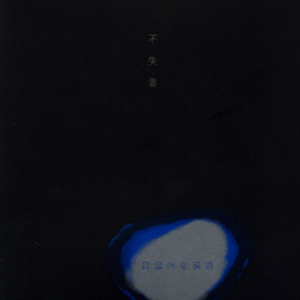 |
allegorical misunderstanding cd - avant - avan 008 - 1993 - japan keiji haino (guitar, voice) yasushi ozawa (bass) jun kosugi (drums) fushitsusha recordings, entry 4 |
|
Consider this. The year is 1993. Haino’s popularity is sky-rocketing around the world. He’s practically the Beatles of underground Japanese experimental music. I swear, this is how it was. Naysayers, be damned. People have been surviving on repeated listening of Live II, as this is the only Fushitsusha album in print and available at the time. The new Fushitsusha album on John Zorn’s Japanese label, AVANT, is highly anticipated. People expect a masterpiece with 15-minute songs powered by raging guitar. What they got was Magic. Were the masses satisfied with Magic? Ho boy! They were not. For some, even Magic did not suffice. What then was this Magic that was delivered? Only another masterpiece. Only a carefully orchestrated, instrumental exercise in using guitar, bass and drums to explore songs that fall expertly in the razor thin interface between the rhythmic and arrhythmic. The first track, Magic I, is one of the greatest Haino tracks of all time. It distills in under three minutes the combination of rhythm and dissonance, so essential to Haino, in a palatable and weightless manner. And it’s lovely to boot. Why were segments of the masses unhappy with this album? It lacked density and power. It was not the brutal assault on all things musical that they felt they had come to expect and deserve from Haino. Did I stand up among the angry throngs and defend the merits of this this Magic? Of course, I did not. I slunk like a coward back to the beat-up dump of a boarding house where I lived in Minneapolis at the time and listened and listened to this Magic a thousand times. If someone asks you, “Is this a jazz album?” The answer is “Yes. Previous and subsequent Fushitsusha albums are located within the rock idiom. Magic is as close to a jazz album as Fushitsusha ever came.” Track 1, Magic I qualifies as one of my top ten favorite Haino tracks. |
|
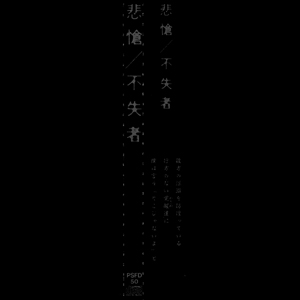 |
hisou (pathetique) cd - psf - psfd-50 - 1994 - japan keiji haino (guitar, voice) yasushi ozawa (bass) jun kosugi (drums) fushitsusha recordings, entry 5 |
|
Hisou is the high-density album that many wanted as a follow-up to Live II. It’s 75 minutes of loud guitar/drums/bass without pausing to catch its breath. Track 1 is a lumbering and bombastic 5-minute introduction to the album. Is it over the top? Yes, it is over the top. If you listen to tracks 2 and 3 (particularly track 3) with Magic in mind, you can hear echoes of it, albeit at a higher volume, extended duration, more frenetic feel and less studio polish. Although I have listened to both Hisou and Magic many times, I didn’t really hear the magic in Hisou until I played them back to back. While there is certainly more power in Hisou, the magic, I feel, is diminished. The last track is a 44-minute guitar serenade of the noisiest sort. From minute 1 through minute 29, the music is nearly indistinguishable. If you play the track on the computer, where you can easily slide the knob changing the position within the song, you can listen to 10 seconds of static at minute 2, 10, 20, or 28 and they are more or less interchangeable. This represents a pretty marked departure from the blues-based songs on Live I or the rhythmic bass lines of Live II or the complex melodies of Magic . The last fifteen minutes of the track, however, move back into a vein similar to tracks 2 and 3, that is, rowdy magic. |
|
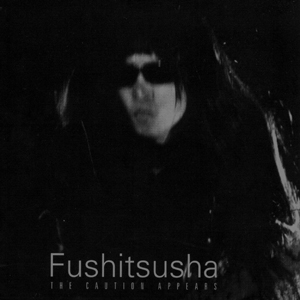 |
the caution appears cd - les disques du soleil et de l'acier - cdsa 54039 - 1995 - france keiji haino (guitar, voice) yasushi ozawa (bass) jun kosugi (drums) fushitsusha recordings, entry 6 |
|
Like any other civilized country, the French love Fushitsusha and The Caution Appears represents the first Fushitsusha release on a French label or any label based outside Japan, although the UK, the US and Canada would eventually follow. Is this a sampler, then, to introduce a broader non-Japanese audience to Fushitsusha? It is a claim that is not altogether without substance. The presence of several 30-second tracks (short guitar riffs) snipped from longer performances indicates there was some attempt to capture “quintessential” Fushitsusha sounds. Can a quintessential sound be presented in 30-second sound byte? Is it necessary to hear the preceding 10 minutes in order to understand the context in which the snippet was intended to exist? Of course, the answer to these questions are respectively “No” and “Yes”. I know I have argued on tracks such as Even Now, Still I Think that I prefer, all other things being equal, my song wrapped up in 17 minutes rather than 72 minutes, but 30 seconds is carrying brevity to an extreme. It’s true that there are longer songs, 4 or 5 or 8 or 10 or even 14 minutes on The Caution Appears, but the mindset has been established. Even these longer songs are snippets, in which the music is presented with a fade-in or a cut tape. What we have here is a compilation of Fushitsusha snippets. They are loud, noisy and free of vocals. There are no songs, only guitar bombardment. Don’t get me wrong; many fans of Fushitsusha profess to love Haino’s guitar bombardment. Some may argue that guitar bombardment is the critical component of Fushitsusha. To this I say, listen to Live I, Live II or Allegorical Misunderstanding. There is more to all of those albums than sonic bombardment. There is a beauty and a music that exists within those albums that I do not find here. |
|
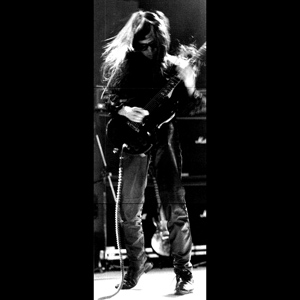 |
untitled (soul's true love) cd - purple trap - pt 004 - 1995 - japan keiji haino (guitar, voice) fushitsusha recordings, entry 7 |
|
This is the fourth disc of the Soul’s True Love box set. The date of recording of this disc is unknown but presumably is from the late 1970’s. As was the case with the other discs in this box, the sound quality rank a strong ok-fi. This disc is attributed to Haino solo on voice and guitar (and percussion) and thus is the only officially released recording of Fushitsusha as a solo entity. In the 1970’s there are no records of solo Fushitsusha performances, while the same do exist for Fushitsusha in various ensembles. For example, eien no ho ga, saki ni te o dashita no sa, which hails from the same period, is a guitar/bass/drums trio characteristic of modern Fushitsusha. One naturally wonders if this solo performance was actually considered a Fushitsusha performance at the time, or whether it was later relabeled a Fushitsusha performance in order to include within the box set, a disc with the popular and marketable Fushitsusha name. That is the conspiracy theorist in me shining through, I suppose. Regardless of the name on the side of the jewel-case, there is music on the disc, which one might find worth addressing in a document of this nature. (Ahem.) The first question one may ask concerns the loveliness of the music. “Is it lovely?” a critic was heard to ask. The safe answer is of course, “Beauty is in the eye of the beholder,” which reveals nothing. Or perhaps, it reveals something, because were we in the presence of an unequivocal, universal beauty, then one could simply answer “Yes.” As it is, we are left with this beholder business, which betrays at best a lack of confidence in the beauty. For example, track 2 is piece for percussion accompanied by moaning with mouth pressed directly against microphone (a Haino staple). Say no more. Say no more. Track 4 is composed of several short guitar-based songs lumped together. It begins with both guitar and percussion, although the percussion appears to be a drum slapped about once every second and a half. (Either there is an uncredited drummer involved, or this is multi-tracked.) The pace of the guitar is equally languid but still carrying a melody. The voice is prominent in the mix and is saturated with emotion. No translations are available, but it’s pretty clear this is a collection of laments. Is this a Fushitsusha album? To this I offer an anecdote involving Swiss cheese. Everyone knows that Swiss cheese is full of holes. Once I was on an airplane and (in this day and age) I paid for a Swiss cheese and Turkey wrap. I unwrapped the tortilla and unwrapped the turkey to examine the soggy cheese within. It had not the faintest smell of Swiss cheese to it. Nor, might I add, did it have any holes in the cheese. “You call this Swiss cheese?” I shouted, enraged. “I have more holes in my ass than there are in this cheese!” Needless to say, my declaration was not met with a warm reception. No indeed. As the clandestine federal air marshals leapt from their seats and pounced upon me, throwing me savagely to the deck of the aircraft and grinding my wrap, unidentifiable cheese and all, under the heels of their boots, I felt that my completely accurate insights had gone sorely unappreciated. |
|
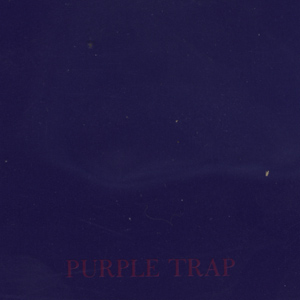 |
purple trap (aka the wound that was given birth to must be bigger than the wound that gave birth) cd - blast first/disobey - bffp 126 - 1996 - england keiji haino (guitar, voice) Yasushi Ozawa (bass) Jun Kosugi (drums) fushitsusha recordings, entry 8 |
|
This double cd set is a live album, recorded in London in 1994, featuring the quintessential Fushitsusha trio of Haino, Ozawa and Kosugi. There are two features that distinguish this record instantly from all other Fushitusha recordings. First, the bass is really high in the mix. There are a bunch of bass lines that sound like they should come from Bill Laswell, which is a comparison that is applicable to Yasushi Ozawa on no other recording, and, as such, can be attributed to the weird mix, at least by me. Second, there is plenty of ambient noise, which is very noticeable during the quieter parts of the performance. What kind of ambient noise would you expect to hear in a London bar? Why, Londoners discussing the various and sundry aspects of their day to day lives. What else? Empty glass beer bottles clinking against each other, as they are deposited into receptacles explicitly designed for such a purpose. While it is true that Haino has played to the accompaniment of crickets and, based at least on this anecdotal evidence, is not above incorporating the sounds of the environment into the recording, the fact that all other live Fushitsusha recordings are free of the bar ambience leads me to believe that this was not an intentional esthetic inclusion. In short, based on these two observations, it sounds like this is an audience (and not a soundboard) recording.
Q: Details of the recording quality aside, what of the music, you ponderous and self-absorbed jackass? Like the dual nature of light, which has characteristics of both particle and wave, so too does this album have a duality. On the front of the disc on a solid dark purple field, are light purple letters, Purple Trap, a name which Haino has used as a self-released label before. However, on the side of the jewel case, there is another, more verbose title, The wound that was given birth to must be bigger than the wound that gave birth. Which is the real title and which the subtitle, the one on the front or the one on the side? I don’t know the answer to this question and I feel at liberty to tell you to do as I have done, and choose whichever suits you on a particular day.
Q: You still have said one iota about the music. Just as a swan has 25,000 feathers on its body while a sparrow has between 1500 and 3500 feathers on its body, so too does Live II have 10,000 accumulated merits, whereas The wound that was given birth to… has between 4000 and 5000 accumulated merits. The discrepancy in the absolute magnitude cannot be purely attributed to size of the beast, for a sparrow has more feathers per square inch of surface. Instead, the difference can more rationally be considered in light of merits per minutes, the density of which reflects the need to stem the relative loss of heat, which is related to the ratio of surface area per unit volume of the beast. You know what I am talking about? Yes, I think you do. Live II is a monument like those found on Easter Island, or that giant black rectangular parallelipipid in Stanley Kubrick’s 2001, while The wound that was given birth to… is more akin to a Henry Moore’s Sheep Piece.
Q: Well, thank you for clearing that up. |
|
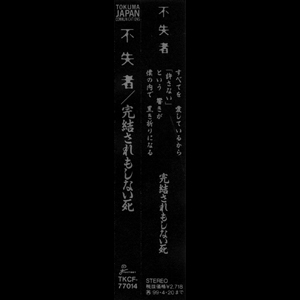 |
a death never to be complete cd - tokuma japan communications - tkcf 77014 - 1997 - japan keiji haino (guitar, voice) Yasushi Ozawa (bass) Jun Kosugi (drums) fushitsusha recordings, entry 9 |
|
A Death Never to be Complete has the best lyrics of any Haino album. The full lyrics translated from the Japanese into English by Alan Cummings are available here. In this review, I focus on a three of my favorite fragments. In the song, Though it went so well?, Haino sings
You miracle yearning for a miracle In these three lines we see the Haino perception of the universe: each individual is a miracle. Life itself is another miracle. The loss of self is the path to happiness. There is a palpable optimism that is not typically associated with self-abnegation. Naturally, these lyrics make me think of The Heart Sutra of the Perfection of Wisdom. In the song, That which is Becoming to Me, Haino sings
The tenderness remembered most What is captivating about these lyrics is the chain of logic. The first couplet associates a nostalgic tenderness with oblivion. When I enter my own oblivion, I want to remember this tenderness as well. In the second couplet, Haino echoes a similar sentiment to my own personal motto, “Not knowing is the triumph of evolution.” The third couplet is the ringer, though. It ties together the first two couplets in a logical statement that itself transcends logic. Perhaps losing the wings is a symbol for moving away from an angelic state, a euphemism for the loss of the internal spark of divinity, the absence of immortality. You don’t need immortality if you can find a tenderness in oblivion. It makes perfect sense and Haino says it in a perfect way. This may be my favorite Haino lyric of all time. In the song, A death never to be complete, Haino sings
This is is this a dream? Here, we sense that this existence is the death never to be complete. That there is an immortality in the fact that it takes forever to reach completion. Is it a dream? Is it rapture? Is it sufficient? No answers in this song, only questions. And, oh yeah, the music on this album is pretty good too. If it isn’t clear yet, this album is almost like a Haino solo album of songs, with bass and drums accompaniment, in contrast to other Fushitsusha albums, where the focus is the combined music of the guitar, bass and drums. This is not a criticism, but rather a point of distinction. This is a welcome album containing six beautiful songs. |
|
 |
the time is nigh cd - tokuma japan communications - tkcf 77015 - 1997 - japan keiji haino (guitar, voice) Yasushi Ozawa (bass) Jun Kosugi (drums) fushitsusha recordings, entry 10 |
|
Along with A death never to be complete, this album was one of two Fushitsusha albums along with a solo album and an improvisational duet with Derek Bailey released on the major label, Tokuma Japan Communications in 1997. The first Fushitsusha album on Tokuma, A death never to be complete, is reviewed above and contains six beautiful songs. The time is nigh takes a different tack. There is a sweet five minute instrumental to open things up and then things get dense. One thirty minute and two twenty minute tracks remind us that Fushitsusha is always capable of the extended bout of sonic bombardment. Yes, there are translated lyrics for the latter three songs, but the vocals certainly play second fiddle to the roar of the instruments. No self-respecting Fushitsusha fan could find fault with this album. It lumbers just as it should. If you play it sufficiently loud, it is fully capable of vibrating knick-knacks off their places on the shelves lining your walls. If you play it at work, people will largely avoid you, which can be a positive or a negative depending upon your relationship with your co-workers. What more can be said about Fushitsusha at this point. Superlatives fail. Of track 3, the inimitable Garry Davis of Arcane Candy and Custom Floor fame wrote, “Black Cluster ... is a nearly half-hour tanker you’d be much more likely to take home to mom. Well, okay, you probably wouldn’t. The vocals are much more up front and the pea sound-soup is a little thinner. Some unbelievable forehead eye psych arches appear later, the likes of which haven’t been heard since track three on Pathetique [Hisou].” That is what I am trying to say, too. Some unbelievable forehead eye psych arches appear. It’s just that Garry said it first. |
|
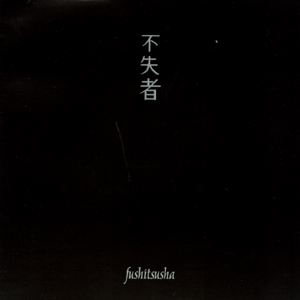 |
gold blood cd - charnel house - chcd 30 - 1998 - usa keiji haino (guitar, voice) Yasushi Ozawa (bass) Jun Kosugi (drums) fushitsusha recordings, entry 11 |
|
Charnel Music was a label run by Mason Jones out of San Francisco that, in addition to this Fushitsusha album, also released a couple compilations with appearances by Haino. Gold Blood is the first and only Fushitsusha album released on an American label. This recording is a portion of a live performance at San Francisco's Great American Music Hall from November 7, 1996 featuring the classic Fushitsusha line-up of Haino, Ozawa and Kosugi. The performance was also broadcast live on KFJC FM. The disc is a hi-fi recording, free of concert hall ambient noises. This is a proper Fushitsusha album, showcasing the epic instrumental soundscapes for which Fushitsusha is known. I have never heard anyone say anything bad about this album. There are four longish tracks of high density and one shortish track (track 4, titled If I had been showered in gold blood, wouldn't my prayer have been answered?) that’s on the mellow side, albeit that is only relative to the other tracks. What does this title mean? Let’s follow the logic. Haino’s prayer would have been answered if only he had been showered in gold blood. This leads to several other questions, such as, “What is Haino’s prayer?”, “What does gold blood symbolize?” and finally “Why would a showering of gold blood increase the probability that a prayer was answered?” Let’s tackle these questions, one at a time, in the order in which they were received. What is Haino’s prayer? To answer this, we can examine the instances of prayer in Haino’s interviews and music. For example, an article by Mike Wood on Perfect Sound Forever contains the following passage.
In a Sept. 1996 Wire interview, Keiji Haino spoke about his music as a form of prayer. While acknowledging that "Prayer exists because nothing is perfect," he felt that his work was an exploration of that imperfection, attempting to voice what was impossible: "I'm trying to express in music the satori that the Buddha achieved but couldn't explain." The prayer is not distinct from the person who prays. They are a single entity as indicated by the title of the collaborative album with Laswell and Ali, Decided...Already the Motionless Heart of Tranquillity, Tangling the Prayer Called "I". It is also clear that words not only are unable to convey the essence of the prayer, but in fact hinder the prayer, as evidenced by the title of the solo album Abandon all words at a stroke, so that prayer can come spilling out. The February 2006 issue of The Wire includes a prayer for the repose of the soul of Derek Bailey by Haino. This lovely sentiment is reproduced on the cover of this document. Taking this information together, one can come up with an educated guess as to the nature of Haino’s prayer. It is for no less than spiritual enlightenment. We can move on to the second question. What does gold blood symbolize? Here there is less direct evidence at hand. Neither gold nor blood are recurring motifs in the lyrics and titles of Haino. Gold is presumably used to mean “precious” and perhaps “most precious”. We can take blood to mean the some integral component of life or the “living essence”. Thus gold blood is the most precious living essence. What is the most precious living essence? I think it may simply be the self recognition of one’s own existence and a wonder at that existence and the world in which it takes place. Obviously then, to be showered with gold blood is to receive this recognition. This interpretation makes the final question trivial. Why would a showering of gold blood increase the probability that a prayer was answered? Obviously, receiving a state of mind containing the most precious living essence, an unwarped perception of one’s own existence and role within the world, would be uselful in the pursuit of spiritual enlightenment. Or so one who is unenlightened may believe. I think this uncertainty is reflected in the fact that Haino’s title is a question. Now, go back and listen to track 4, If I had been showered in gold blood, wouldn't my prayer have been answered?. It’s less than 8 minutes. Tell me if you don’t think I hit the nail on the head. |
|
 |
a little longer thus cd - tokuma japan communications - tkcf 77020 - 1998 - japan keiji haino (guitar, voice) Yasushi Ozawa (bass) Ikuro Takahashi (drums) fushitsusha recordings, entry 12 |
|
Tinkering. No one has every accused Fushitsusha of tinkering around, making small noises on the instruments in a vaguely non-musical manner, which is one stereotype of a characteristic class of small ensembles in the European Free Improvisation idiom. That said, track 1 is a couple minutes of true blue tinkering. It starts this album off on a very atypical foot. This album was included in the second batch of four cds released by Tokuma Japan Communications in 1998. The first batch included two Fushitsusha albums A death never to be complete and The time is nigh. In the reviews above, it is noted that A death never to be complete is an album of Haino songs with bass and drums accompaniment while The time is nigh showcases the more traditional extended power guitar/bass/drums instrumentals of Fushitsusha. Perhaps this album, A little longer thus is intended to showcase yet another side of the band, one that is further away from the rock and roll idiom than the previous albums. This album is more improvisational in sound and less musical. The repeated rhythms on track 2 are intentionally dissonant and have no precedent in the Fushitsusha catalog. One might think that Fushitsusha moved from the rock idiom to the jazz idiom once before (Allegorical Misunderstanding), but this is not really a jazz album either and it does not possess the intense lightness of Allegorical Misunderstanding). This change of approach is not universally appreciated. At least one reviewer has claimed that this album sounds like a toss-off to satisfy a contractual obligation. It’s an observation that is not altogether without merit, as there is little attention to production, as evidenced by the phone ringing in the background at 3:20 of track 3. However, it is hard to imagine Haino giving a lackluster effort to his music. His music is always about intensity, albeit every once in a while a quiet intensity. I prefer to think of this album as an intentional change of idiom, showcasing of heretofore unseen side of Fushitsusha. In addition to the change in idiom, the tracks are largely very sparse. There is no trademark high density to any of these tracks. In fact, several tracks seem to be a vocals/bass/drums trio, completely free of Haino’s guitar. I don’t think that Haino has previously participated in a voice/bass/drums trio, but I could be wrong, am likely wrong, am dead wrong, never been more wrong, never been right about anything, etc., etc. One other note: the last track, the title track, is a guitar and voice song. It is a beautiful little song that has nothing in common with the previous 8 tracks on the album. I guess Haino just put it on there because it was too good to file away and he didn’t have anywhere else to put it. Before I go, I have to ask this important question. Who was that calling on the phone at 3 minutes and 20 seconds into track 3, titled Within Two Times? I will tell you who it was, but you must promise never to speak of it again. It was the voice born within two times. We do not know where it wishes to go, we only know how tightly it will ensnare us, were we to answer its call. It would probably speak a word birthed between that where is and that where is not, if you know what I mean. Murderous intent. I wouldn’t have answered the phone either. In fact, I may never answer a phone again, so don’t bother calling me. |
|
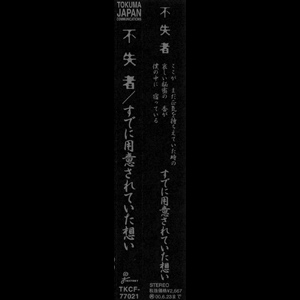 |
the wisdom prepared cd - tokuma japan communications - tkcf 77021 - 1998 - japan keiji haino (guitar, voice) Yasushi Ozawa (bass) Ikuro Takahashi (drums) fushitsusha recordings, entry 13 |
|
Once I was reading a book titled, The Wisdom Unprepared, and I was like, how can you have an unprepared wisdom. Wouldn’t a wisdom naturally be prepared for whatever came its way? Doesn’t preparedness come part and parcel with wisdom? Oh, how relieved I was when I saw that the last Fushitsusha album to be released on Tokuma Japan Communications was titled The Wisdom Prepared. Everything was set right in the world. No, you are right; that never happened. One track—75 minutes of high density guitar/bass/drums without stopping. Whole forests could have been toppled with the chainsaw of this album. Of course, nowadays we don’t engage in such environmentally insensitive metaphors. Instead we like to say the following. In the presence of this music algae were 10% more efficient at producing the green-house-gas free fuel, hydrogen, from sunlight and water, than they were listening to Mariah Carey’s opus, Butterfly. That means it was rockin’, bro! |
|
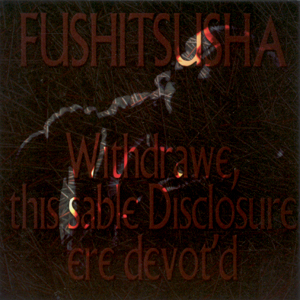 |
withdrawe, this sable disclosure ere devot'd cd - les disques victo - victo 060 - 1998 - canada keiji haino (guitar, voice) Yasushi Ozawa (bass) Ikuro Takahashi (drums) fushitsusha recordings, entry 14 |
|
The Festival International de Musique Actuelle de Victoriaville, or FIMAV as it is affectionately known is a avant garde music festival held in Quebec, which celebrated its 25th anniversary in 2008. It has been held annually, although there was no installment in 2009. Many notables in the world of experimental music have performed at FIMAV over the years and Haino is no exception. This album is recorded live at the 14th FIMAV on May 16, 1997. It is not Haino’s only appearance. He has subsequently played as part of Kikuri as well. Les Disques Victo is a Canadian label that supports the festival and releases a many live performances from the festival. There is a lot of goodness in this hour-plus 8-track performance. There is some heavy sonic bombardment from on high (track 1) and some volcanic noisy eruptions from below (track 8). We get some trademark anthemic dirges (track 2) and hoarse vocalizations over a bass/drums improve a la A little longer thus (tracks 3 and 4). We get a short and sweet Haino song (track 5) and an extended audio sculpture of varying textures of intensity (track 6). We wrap it up with some weird (intentionally) mistimed funk (track 7). What more do you want? Magic? Monumental Fushitsusha edifices of sounds? For those refer to Allegorical Misunderstanding and Live I respectively. Regardless, the audience captured on this live performance is very enthusiastic, always a plus in live recordings, I know. |
|
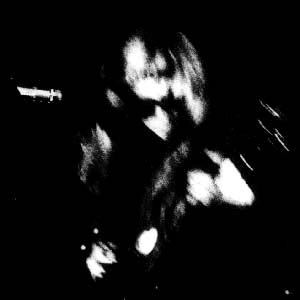 |
i saw it! that which before I could only sense... cd - paratactile - ple1106/07-2 - 2000 - england keiji haino (guitar, voice) Yasushi Ozawa (bass) Ikuro Takahashi (drums) fushitsusha recordings, entry 15 |
|
Like many of you, I wonder what the name of this label, Paratactile means. Is it an adjective describing a document filled with parataxis, the placing of clauses without coordinating connectives? Is it rather a compounding of the prefix para- and the word tactile, like paranormal. Paratactile: a string of uncoordinated phrases or beyond touch. Perhaps both, a string of uncoordinated phrases describing a sensation beyond touch. Probably that. It’s how I like to think of my reviews.
“Hi, honey. How was work today?” The late Trevor Manwaring founded both the Chronoscope Records and Paratactile labels, which ceased issuing records in 2004. There were several notable recordings on Paratactile, including three with Derek Bailey: a trio with RUINS (no not the one on Tzadik, a different one), a totally incomprehensible (to me) Derek Bailey feedback album, and a genuinely brilliant cd of Bailey reading some modern poetry as he plays the guitar. The only other record I have heard on this label is a self-titled album by MASS, a guitar/bass/drums trio led by Gary Smith, the title of which belies an affinity for substantive density, a trait shared in common with, believe it or not, Fushitsusha. If you haven’t gotten it by now, I just can’t garner any appreciation for “samplers”, where you get a little bit of this and a little bit of that. If you are having appetizers at a Middle Eastern restaurant, then by all means order the sampler, but don’t put it in my Fushitsusha album. In part, that is why this double cd is refreshing. It is two hours of unadulterated and unmitigated and uncontaminated supercharged bliss. Fushitsusha turns the distortion up high and roars forth. Is this a sonic monument in the vein of Live I. Yes, but only in concept. Live I featured songs with melodies. This release, I saw it, that which before I could only sense, is more abstract, more guttural. The title track is 85 minutes long. That’s right I said 85 minutes long. It had to be broken over two discs. Thirty minutes at the end of disc one and a healthy 55 minutes to start disc two off. Put that in your peace pipe and smoke it, America. This reminds of a time back in February of ’76 when RUSH released 2112 and the title track was too long and they had to put the last couple minutes of it on side B. That hurt me. I wanted it all on side A. I wanted it all uninterrupted. The damn thing was only 20:32. It could have fit on one side. Anyway, this problem was fixed when they reissued it on cd. But, back to Fushitsusha, I suppose we will have to wait until the next media format comes out to get the uninterrupted 85 minute track. By then, will there still be the widespread public clamoring for an uninterrupted version o f I saw it, that which before I could only sense as there was for 2112? Shame on you if you need to ask. For this album, I can forgive Paratactile for the DB feedback album. |
|
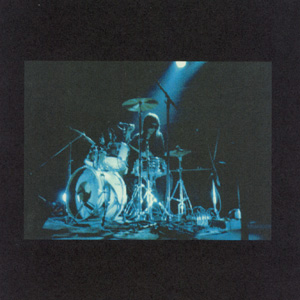 |
origin's hesitation cd - psf -- psfd 8010 - 2001 - japan keiji haino (drums, voice) Yasushi Ozawa (bass) fushitsusha recordings, entry 16 |
|
Well, the drummer quit the band. So it goes. It has happened to many bands over the course of history. But, I ask you this, how many times has the lead guitarist quit the guitar, taken up the drums, and released the next album with him drumming and no guitarist at all? I think the instances of such are few and far between. It happened here, though. Haino is drumming and singing. Yasushi Ozawa plays bass. Did someone in a far flung spot of the world find this release to be a refreshing departure for Fushitusha. I am sure that they did. Did I? No, I did not. If Haino decided to release a bass/drums record, then we could all take that in and judge it on its own merits. However, by calling this album a Fushitsusha album, it is asking for us to compare it to previous Fushitsusha albums. But now imagine this: A Fushitsusha album with no guitar. Horror upon horrors! How can such an abomination against nature exist at all? Okay, I exaggerate, but the point is there. We wanted guitar in our Fushitsusha. The previous fifteen Fushitsusha releases had gotten us accustomed to having guitar in our Fushitsusha. If someone were to serve you a peanut butter and jelly sandwich with no peanut butter in it, you would say, “What the hell is this?” If it was a person that you really liked giving you a PB&J with no PB, you might say, “Umm, excuse me, where’s the PB?” But, either way, the sentiment is the same. You cannot have a PB&J sandwich without the PB. So while others, more magnanimous and possessed of greater faculties of musical appreciation than I might find something new to explore in a guitar-less Fushitsusha, I simply call it a gutted Fushitsusha. Pitiful. A pitiful pitstop on the great experimental journey that was Fushitsusha and a lamentable last official release of Yasushi Ozawa prior to his death in 2008. If we try to accept the music on its own terms and ignore the Fushitsusha legacy which it otherwise despoils, then we have essentially a Haino drums/vocal recording with a little bit of bass here and there. For those of you who are not reading these reviews in the order in which they were presented, I will note that the Haino solo album on conventional drum kit released four years later in 2005, kono kehai fujirareteru hajimarini, ranks as my least favorite Haino album ever. This album at least has voice and bass guitar. If I wanted to I could study the interplay of silence, percussion, intermittent plucking of bass guitar strings with the rasping and shouting of Haino’s voice. I probably have the writing capacity to put together a paragraph describing such a thing and to make it sound worthy of investigation. Perhaps it is genuinely worthy of investigation. As I listen to it, the music begs me not to write this insolent and offensive review, but to rather delete the whole thing and start over with a legitimate discussion of the merits of the music. But I will not. I provide the obvious kneejerk reaction. There is no guitar! Why? Why am I not more thoughtful? Why did the Good Lord in Heaven Above put me on the earth to be an insolent jackass? If I had the answer to those questions, wouldn’t that be a pretty pie? Oh indeed it would. Sadly or perhaps luckily I have so such answers. If I listen to the music carefully, the bass on track 3 is an inducement to weeping. This is a tangible foreshadowing of tragedy and you can hear it in the music. Death will come to us all! Repent! Repent for the end is near! |
|
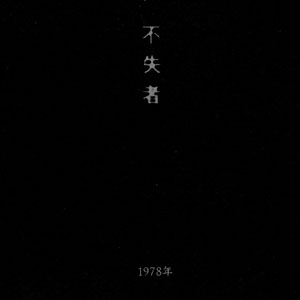 |
eien no ho ga, saki ni te o dashita no sa (it was eternity that reached out first...) cd - psf -- psfd 8016 - 2003 - japan keiji haino (drums, voice) Jun Hamano (bass) Takashima (drums) fushitsusha recordings, entry 17 |
|
What were you doing in 1978? I was playing with Star Wars Action Figures, much the same as I do today. What were you listening to in 1978? I was probably still listening to my Dad’s lps of cowboy music from the likes of Marty Robbins and Frankie Lane, much as I still do today. Not much changes in 30 years when you are sedentary barnacle such as myself. But, enough about me, let’s talk about what Fushitsusha was doing in 1978. They were a guitar/bass/drums trio, as they would remain through-out their golden era. The personnel were different. And the sound? Well, 25 years later when Haino couldn’t or wouldn’t get a new drummer for Fushitsusha and he and Ozawa were touring the world as a guitar/bass duo incarnation of Fushitsusha and more or less underwhelming audiences everywhere for lack of a drummer, Haino decided to release an old recording when he still had a drummer. Wise choice. If I had been in his shoes, I would have done the same, at least, until I could find a new drummer. Anyway, this is it. We have gotten a fair few releases of Haino music from the 1970s, issued long after the date of recording. Some of it, like Lost Aarraaf is a terrifically different sort of music for Haino and stands strongly on its own merits. Some of it, like certain albums on the Soul’s True Love box set, the following can be said, “There is a reason this music wasn’t released when it was recorded; it has very little to recommend it except as a reference and a window into his early developmental years, by which later releases, much more highly polished and artistically developed can be measured.” Where does this Fushitsusha album fit in this spectra? Closer to Lost Aarraaf than The Third Heart, I would say. It has its own merits and isn’t solely interesting as a counterpoint to Haino’s more recent releases. What makes track one different than modern Fushitsusha is only the fact that the distortion effects on the guitar are lacking. I am serious. If Haino had the same pedals and gadgets in 1978 that he had now, this track would be a blasting roar. Without it, the guitar sounds comparatively puny. (The only flaw in this reasoning is the fact that Haino’s 1973 solo guitar album, Ama no gawa, has a modern full-blast sound despite its early origin.) The 35-minute second track is experimental guitar/bass/drums in a more free improv vein. There is no song and no melody. Still, Haino begins to sing as if there were a song, as if there were melody, but the only melody is in his voice. None of the instruments provide any harmonic accompaniment. Ultimately, the question is, “Does the music engage you? Is there something that keeps you actively listening for 35 minutes?” Otherwise, the music has failed. Otherwise the music is background noise and could just as well be the rumble of the subway or the chatter of voices across the hall or whatever particular sounds one would otherwise hear if the music were not playing. To that I say, it is hard to keep the ears interested for half an hour. A masterpiece like Koko can do it. This music would not likely have sat for 25 years waiting to be released if it were a masterpiece. On the contrary, this track is a sketch, a practice for something that would be perfected 20 years later. It’s cool to hear the early indications of Fushitsusha’s greatness to come. It’s cool. It’s there. It’s real. Perhaps, this is not the last Fushitsusha release. Perhaps there will be other recordings that emerge “from the vault”. Perhaps, perhaps, perhaps. As Donald Barthelme wrote in the short story The Great Hug, “This is my best balloon…the balloon of perhaps”. |
|
|
closing to fushitsusha recordings
|
|
|
proceed to lost aaraaff recordings
all text copyright david keffer.
distribution without consent is prohibited.
contact the author. |
|